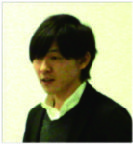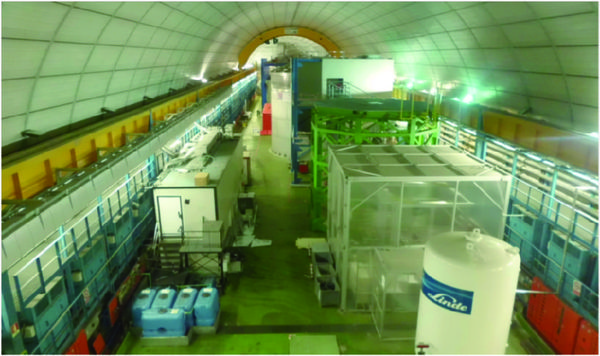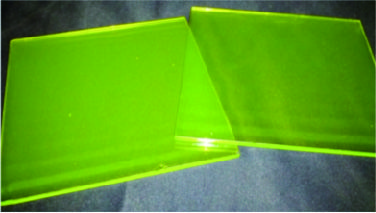Features
Features
Super High-resolution Nuclear Emulsion for Directional Dark Matter Search
- ツイート
- 2017/11/09
Kobayashi-Maskawa Institute for the Origin of Particles and the Universe (KMI) / IAR
Designated Assistant Professor Tatsuhiro Naka
Source: IAR Letter, vol.14, March 2016
*about IAR: Nagoya University's Institute for Advanced Research was established to produce internationally recognized academic research of the highest caliber, and to contribute to society through the research achievements at the Institute.
Fig.1 Underground laboratory of the Gran Sasso National Laboratory (LNGS), Italy
The problem of dark matter is one of the most important subjects for natural science; elucidation of its character leads to understanding of the very origins of the universe. Direct dark matter search on the earth is the most promising method for discovering and understanding its character. In particular, direction-sensitive dark matter search is a powerful method for searching with high reliability, because the direction of dark matter on the earth is expected to exhibit unisotropy, and data thereof should constitute evidence for identifying dark matter signals. This study proposed using a super high-resolution nuclear emulsion as a detector, and the development of various new devices and technologies raised the possibility of carrying out such a method. International collaboration has now been established and promoted as the "NEWS (Nuclear Emulsion for the WIMPs Search)" project at the Gran Sasso National Laboratory, Italy.
INTRODUCTION
The advance of technologies for observing the universe have resulted in the understanding that, in particular very high precision measurement of cosmic microwave backgrounds (CMB) indicate that elements comprising ordinal matter account for just 5% of the total energy of the universe, while the remainder consists of unknown dark elements (1). In particular, dark matter observed due to the effect of gravity (e.g., the rotation of the galaxy and gravitational lensing) is currently one of the most important subjects to be grasped in natural science. The existence of dark matter in the Milky Way galaxy has been understood by measuring rotational velocity (2)(3), and local dark matter density around the solar system can be estimated as 0.4 GeV/cm3 . This means that the flux of dark matter on the earth is expected to be approx. 106 /cm2 /sec in the case of hydrogen equivalent mass. Therefore, direct dark matter search on the earth is the most important approach for directly elucidating this.
Direct detection of dark matter through direction sensitivity
Direct search for dark matter is possible in principle by the detection of recoiled nuclei induced by dark matter. However, the possibility of finding such recoiled nuclei depends on the event rate, which is affected by interaction possibilities, the mass of dark matter particles, the amount of target mass, the detectable energy threshold, and background levels.
There are two main methods used to identify dark matter: that using annual modulation, and that using direction asymmetry. For example, the number of signals varies depending on the relative velocities between the dark matter and the earth moving around the sun. This means the dark matter signals are expected to exhibit behavior with annual modulation. Current major experiments aim to observe this behavior, but as it has a modulation of a few percent, there are some difficulties in identifying dark matter clearly. The direction-sensitive method is a powerful method for identifying dark matter using the asymmetry of the angular distribution of signals and lower statistics than the annual modulation method (4). However, no appropriate detectors have been made yet that exhibit perfect performance, because the technologies for obtaining directional information to target energy (less than approx. 100 keV) for dark matter detection are currently poor.
The motivation of this study is to make feasible an original direction-sensitive detector for an interesting dark matter model, and to promote a project to carry out large scale directional dark matter search.
Directional dark matter search with nuclear emulsion
We proposed a super-high resolution nuclear emulsion as a direction-sensitive dark matter detector. However, this was a big challenge because, although nuclear emulsion detectors have a very long history, in this study, quite new devices, readout systems and various technologies for background rejection with quite different qualities from current technologies had to be created from scratch. In the following section, summaries and the statuses of new technologies and projects will be introduced.
Fine-grained nuclear emulsion
The requirements for a direction-sensitive dark matter detector are very high spatial resolution, scalability, and low background. In particular, such resolution requires detection performance of better than submicron level of nuclear recoil signals due to dark matter in order to obtain directional information, but no such detector yet exists in the world. Here, we focused on nuclear emulsion. Nuclear emulsion is kind of photographic film, but it functions as a particle or radiation detector that can obtain 3D information of tracks with very high spatial resolution (approx. 1 µm). However, its current performance is very poor for this purpose. So, to improve the resolution, the idea was to micronize a silver halide crystal, which worked as a sensor for the device similar to a CCD camera. In 2010, the original machine designed to realize this was installed in Nagoya University, and the original production method was established. Here, the crystal size was controlled to the accuracy of several nanometers, and the new device was named the Nano Imaging Tracker (NIT) (5) (Fig.2). Intrinsically, this device can detect particle tracks of more than 50 nm in length, and the detector has the highest resolution in the world. Additionally, we succeeded in the demonstration of detection performance to target energy for dark matter search.
Fig.2 Fine-grained nuclear emulsion device for directional dark matter search developed by our group at Nagoya University
High resolution readout
Recorded events at the NIT have to be read out and output as data automatically. Readout technologies and performance are one of the most important factors for defining the achievable experiment scale and sensitivity. As technologies for achieving this, quite new methods and algorithms were proposed (6) and demonstrated (this was an innovative approach, because conventional nuclear emulsions have continued to utilize fundamentally the same algorithms for 30 years).
In this research, a new analysis system based on an optical microscope was constructed, and it became possible to read out submicron length tracks of more than 100 nm automatically, with an angular resolution better than 30 degrees. This system would perform the function of screening candidate tracks, and an additional step to distinguish and confirm the signals from the backgrounds would be required. Such systems were also newly developed in this research. For example, a hard X-ray microscope was one of the tools used to realize this, because this system can achieve both non-destructive and super resolution (of about 60 nm). In this study, a new system using a hard X-ray microscope at Spring-8 of JASRI was developed in collaboration with
SPring-8 (7). As an additional method, localized surface plasmon resonance (LSPR) is a very interesting phenomenon, and can be applied to super-resolution analysis, and this is already demonstrated to achieve 10 nm spatial resolutions under an optical microscope. We are constructing a practical application system using such new information.
Low-background technologies
As the interaction strength of dark matter to standard matter should be very low, various contaminations have to be considered as the background source. For example, environment radioisotopes will produce serious background noise despite being very low-level. Environmental radiation from radioisotopes around the detector can be shielded in principle; however, intrinsic radioactivity etc., is the most serious. We were able to obtain data for the quantitative amount of such radiation using a pure Ge detector and ICP-MS, etc.. Currently, background rejection studies are the main topic of study, and we are developing various technologies to reject background (e.g., chemical sensitivity control, cryogenic devices, and so on).
The news project
The above technical breakthrough proved to be an important step for promoting the project. Now, international collaboration has been established as the "NEWS (Nuclear Emulsion for WIMPs Search)" project, and organization of the project and the making of a proposal are under way. Currently, the participating countries are Japan, Italy, Turkey and Russia, and about 50 persons have signed the previous Letter of Intent.
As cosmic rays or radiation induced by cosmic rays present the risk of producing fake signals in the search for exotic particles such as dark matter, an experimental field located deep underground is required, with rock providing a shield from cosmic rays. This project will be started at the Gran Sasso National Laboratory (LNGS) in Italy, which has a very large laboratory about 1000 m underground (Fig.1). We will start the first pilot run in the coming two years.
Acknowledgements
This work was supported by JSPS KAKENHI Grant Number 23840018, 25800140, 15H05446 26104005, and the YLC program of the Institute for Advanced Research at Nagoya University.
References
(1) P. A. R. Ade (and Planck collaboration), Astronomy & Astrophysics, 571, A10 (2014)
(2) D.P.Clemens, Astrophys. J. 295, 422-436 (1985)
(3) C. S. Oh, H. Kobayashi, M. Honma, T. Hirota, K. Sato and Y. Ueno, Publ. Astron. Soc. Japan 62, 101-114(2010)
(4) D.N.Spergel, Phys. Rev. D 37, 1353(1988)
(5) T. Naka et al., Nucl. Inst. Meth. A 718 (2013) 519-521
(6) K. Kimura and T. Naka, Nucl. Inst. Meth. A 680, 12-17 (2012)
(7) T. Naka et al., Rev. Sci. Instrum. 86, 073701 (2015)
 |
Tatsuhiro NAKA: Designated Assistant Professor of the Young Leaders Cultivation Program Center of Experimental Studies, Kobayashi-Maskawa Institute / Institute of Advanced Research, Nagoya University |
Related Links
- download IAR_letter_Naka.pdf
- Kobayashi-Maskawa Institute for the Origin of Particles and the Universe (KMI), Nagoya University
NU Research
(English)



